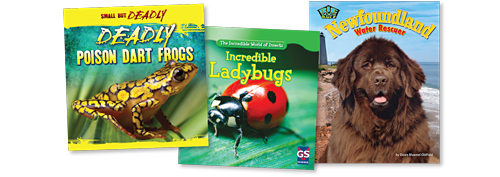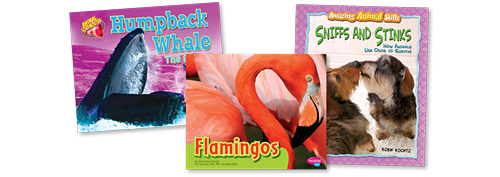2018 School Spending Survey Report
Strange, Enormous, and Extraordinary: Animals | Series Made Simple Fall 2011

Preschool-Grade 4
ALLYN, Daisy. Deadly Blue-Ringed Octopuses. ISBN 978-1-4339-5734-5; ISBN 978-1-4339-5736-9; ISBN 978-1-4339-5735-2. LC 2010049784. JAMES, Lincoln. Deadly Poison Dart Frogs. chart. ISBN 978-1-4339-5742-0; ISBN 978-1-4339-5744-4; ISBN 978-1-4339-5743-7. LC 2011009417. LEIGH, Autumn. Deadly Pufferfish. ISBN 978-1-4339-5746-8; ISBN 978-1-4339-5748-2; ISBN 978-1-4339-5747-5. LC 2010052573. RICHTER, Abigail. Deadly Mosquitoes. ISBN 978-1-4339-5738-3; ISBN 978-1-4339-5740-6; ISBN 978-1-4339-5739-0. LC 2011006081. ROZA, Greg. Deadly Bacteria. reprods. ISBN 978-1-4339-5726-0; ISBN 978-1-4339-5728-4; ISBN 978-1-4339-5727-7. LC 2010045995. ----. Deadly Black Widows. ISBN 978-1-4339-5730-7; ISBN 978-1-4339-5732-1; ISBN 978-1-4339-5731-4. LC 2010047159. ea vol: 24p. (Small But Deadly Series). photos. further reading. glossary. index. Websites. CIP. Gareth Stevens. 2011. PLB $22.60; pap. $8.15; ebook $22.60. Gr 2-5-Fans of venomous animals should enjoy this series. While the books have definite appeal for reluctant readers and browsers, they also offer plenty of information for reports. The volumes cover each creature's range/habitat, life in a group, physical characteristics, life cycle, and venom/poison (or the diseases it causes in the case of Bacteria and Mosquitoes). The titles each end with a section on people's relationship with the subjects, including how they sometimes can actually help us. The spreads have about two paragraphs of text, large color photos with captions, and "Deadly Data" fact boxes. Although adults may find the layouts busy or distracting, the designs should attract children. ANTILL, Sara. A Bear's Life. map. ISBN 978-1-4488-4977-2; ISBN 978-1-4488-5101-0; ISBN 978-1-4488-5339-7. LC 2010048487. ----. A Crocodile's Life. map. ISBN 978-1-4488-4976-5; ISBN 978-1-4488-5100-3; ISBN 978-1-4488-5336-3. LC 2010047846. ----. An Elephant's Life. map. ISBN 978-1-4488-4979-6; ISBN 978-1-4488-5106-5; ISBN 978-1-4488-5366-3. LC 2010050513. ----. A Horse's Life. ISBN 978-1-4488-4980-2; ISBN 978-1-4488-5108-9; ISBN 978-1-4488-5367-0. LC 2011000096. ----. A Shark's Life. map. ISBN 978-1-4488-4981-9; ISBN 978-1-4488-5110-2; ISBN 978-1-4488-5368-7. LC 2010053109. ----. A Whale's Life. map. ISBN 978-1-4488-4978-9; ISBN 978-1-4488-5104-1; ISBN 978-1-4488-5340-3. LC 2010049067. ea vol: 24p. (Living Large Series). photos. glossary. index. Websites. CIP. Rosen/PowerKids Pr. 2011. PLB $21.25; pap. $8.25; ebook $21.25. Gr 2-4-This series introduces readers to large animals that are popular report topics. Each title covers the animal's size, growth, habitat (most have a map), diet, life cycle, and relationship with humans (including if any species are endangered). Sometimes the same information is repeated in different sections of the text, which may confuse youngsters who read the books straight through. In Whale's Life, readers are told that the 150-ton blue whale is about five times as heavy as the 40-ton humpback whale. Large photographs and text boxes work together to create an attractive layout, but sometimes the photographs don't represent the same species that is discussed on that particular page. ASHLEY, Susan. Incredible Ants. diags. ISBN 978-1-4339-4571-7; ISBN 978-1-4339-4572-4; ISBN 978-1-4339-4574-8. LC 2010035219. ----. Incredible Bees. ISBN 978-1-4339-4575-5; ISBN 978-1-4339-4577-9; ISBN 978-1-4339-4576-2. LC 2010035220. ----. Incredible Butterflies. ISBN 978-1-4339-4579-3; ISBN 978-1-4339-4580-9; ISBN 978-1-4339-4582-3. LC 2010035221. ----. Incredible Fireflies. ISBN 978-1-4339-4583-0; ISBN 978-1-4339-4584-7; ISBN 978-1-4339-4586-1. LC 2010035222. ----. Incredible Grasshoppers. ISBN 978-1-4339-4587-8; ISBN 978-1-4339-4588-5; ISBN 978-1-4339-4590-8. LC 2010035238. ----. Incredible Ladybugs. ISBN 978-1-4339-4591-5; ISBN 978-1-4339-4592-2; ISBN 978-1-4339-4594-6. LC 2010035240. ea vol: 24p. (The Incredible World of Insects Series). photos. further reading. glossary. index. Websites. CIP. Gareth Stevens. 2011. PLB $22.60; pap. $8.15; ebook $22.60. K-Gr 2-These books start with the basics. For example, in Ladybugs readers learn that "Ladybugs are not all ladies." Each book covers the insect's appearance, body parts, movement, and life cycle. With short, declarative sentences, a large font, ample spacing, and color photos to support the text, these volumes are ideal for beginning readers. They could be used for reports, but important facts that children often look for are not included. None of the titles mentions the insects' geographical range or their predators, and only Bees and Ladybugs describe the insects' diets. In addition, Butterflies refers to a cocoon rather than the preferred term chrysalis. GOLDISH, Meish. Rottweiler: Super Courageous. ISBN 978-1-61772-298-1; ISBN 978-1-61772-337-7. LC 2011015914. LUNIS, Natalie. German Shepherd: Super Smart. ISBN 978-1-61772-299-8; ISBN 978-1-61772-333-9. LC 2011011348. OLDFIELD, Dawn Bluemel. Newfoundland: Water Rescuer. reprods. ISBN 978-1-61772-296-7; ISBN 978-1-61772-336-0. LC 2011019413. PERSON, Stephen. Great Dane: Gentle Giant. reprods. ISBN 978-1-61772-297-4; ISBN 978-1-61772-334-6. LC 2011014732. RUDOLPH, Jessica. Labrador Retriever: Most Popular. reprods. ISBN 978-1-61772-300-1; ISBN 978-1-61772-335-3. LC 2011009372. ----. Saint Bernard: Mountain Rescuer. reprods. ISBN 978-1-61772-295-0; ISBN 978-1-61772-338-4. LC 2011002431. ea vol: 32p. (Big Dogs Rule Series). diags. chart. map. photos. bibliog. further reading. glossary. index. Websites. CIP. Bearport. 2011. PLB $25.27; ebook $18.95. Gr 3-5-To pull readers in, each title begins with the story of an individual dog helping humans. The rest of the chapters cover the history of the breed, physical characteristics, temperament, and training. Maps show the dogs' various places of origin. "At a Glance" fact pages succinctly summarize data such as size, color, and life span, while the "Best in Show" diagrams delineate what judges look for in each breed. The colorful spreads each contain two or three paragraphs of text, photos, and sidebars (shaped like dog tags). Although there is some material on what type of home is best for each breed, these are not pet-care guides.
Grades 5 & Up
HARRIS, Tim, ed. Birds. ISBN 978-1-936333-31-8. LC 2010053975. ----. Fish. ISBN 978-1-936333-32-5. LC 2010053976. ----. Invertebrates. ISBN 978-1-936333-33-2. LC 2010053967. ----. Mammals of the Northern Hemisphere. ISBN 978-1-936333-34-9. LC 2010053969. ----. Mammals of the Southern Hemisphere. ISBN 978-1-936333-35-6. LC 2010053970. ----. Reptiles and Amphibians. ISBN 978-1-936333-36-3. LC 2010053968. ea vol: 64p. (Facts at Your Fingertips: Endangered Animals Series). charts. illus. maps. photos. further reading. glossary. index. Websites. CIP. Brown Bear Bks. 2011. PLB $35.65. Gr 7 Up-Organized in an encyclopedia style, each book covers more than 20 endangered species, devoting a spread to each one. An introduction provides context on the whole group. A data panel for every profiled creature lists basic information, such as scientific name, population, range (with map), size, diet, and breeding, while the text focuses on how the animal lives and why it's endangered. The categories of threat (vulnerable, endangered, etc.) assigned by the International Union for Conservation of Nature are included, along with an explanation of these classifications and facts about other conservation organizations. Due to the dense amount of information, these titles would most likely be used by students seeking resources for assignments; unfortunately, some animals (such as the sea otter and Steller's sea lion) have been omitted from the index, and others (such as the kiwi) must be located under their full name (Northern brown kiwi). HIBBERT, Clare. Beetles. ISBN 978-1-84837-957-2. LC 2011005599. ----. Birds. ISBN 978-1-84837-958-9. LC 2011005600. ----. Butterflies and Moths. ISBN 978-1-84837-959-6. LC 2011005551. ----. Fish. ISBN 978-1-84837-960-2. LC 2011005601. ----. Snakes and Lizards. ISBN 978-1-84837-961-9. LC 2011005602. ----. Spiders. ISBN 978-1-84837-962-6. LC 2011005603. ea vol: 32p. (Really Weird Animals Series). photos. further reading. glossary. index. Websites. CIP. Arcturus. 2011. PLB $28.50. Gr 3-5-Each title introduces readers to more than 15 different animals. Fact boxes present information about the size, home, and diet of the creatures, and text boxes scattered throughout contain interesting facts. Though students may be familiar with some of the animals, many will be new to them, and the details truly are fascinating; for example, crab spiders can disguise themselves as bird droppings. Unfortunately, there are no introductions to give readers context about the types of species. The large photos and small sections of text make these good choices for reluctant readers, and they are certain to attract browsers. However, due to the brevity of the information, they won't be as useful for reports. KOONTZ, Robin. Leaps and Creeps: How Animals Move to Survive. ISBN 978-0-7614-4906-5; ISBN 978-1-60870-599-3. LC 2010016861. ----. Movers and Makers: How Animals Build and Use Tools to Survive. ISBN 978-0-7614-4910-2; ISBN 978-1-60870-603-7. LC 2010039660. ----. Screams and Songs: How Animals Communicate to Survive. ISBN 978-0-7614-4907-2; ISBN 978-1-60870-600-6. LC 2010016875. ----. Sniffs and Stinks: How Animals Use Odor to Survive. ISBN 978-0-7614-4908-9; ISBN 978-1-60870-601-3. LC 2010016862. ----. Spits and Squirts: How Animals Squirt to Survive. ISBN 978-0-7614-4909-6; ISBN 978-1-60870-602-0. LC 2010016863. ea vol: 48p. (Amazing Animal Skills Series). illus. photos. further reading. glossary. index. Websites. CIP. Marshall Cavendish/Benchmark. 2011. PLB $29.93; ebook $29.93. Gr 4-6-This series highlights adaptations animals have made to subsist in their environments. Each title has seven chapters that describe one aspect of the overall topic. For example, in Sniffs, the first section introduces readers to the olfactory physiology, while the remaining chapters cover how animals use odors (or their sense of smell) to attract mates, mark their territory, defend themselves from predators, communicate, and find food. The last chapter features animals with superb sniffing abilities. Koontz writes in an informal style, often engaging readers by addressing them directly; she doesn't hesitate to discuss the gross-out facts that appeal to kids. A mix of color illustrations, photos, and text boxes breaks up the narrative. Since most animals are covered in one paragraph, students might not find enough information for reports, but these titles are captivating pleasure reading, and they will be valuable where animal adaptations are a part of the curriculum. For younger students, the best option is Capstone's "Colorful World of Animals," while for intermediate grades, Marshall Cavendish's "Amazing Animal Skills," Bearport's "Big Dogs Rule," and Gareth Stevens's "Small But Deadly" would all be good choices. If you need additional materials on the topics, Arcturus's "Really Weird Animals," Bearport's "Animal Loudmouths," ABDO's "Australian Animals," QEB's "Camouflage," Heinemann's "Creatures of the Deep," and Brown Bear Books's "Facts at Your Fingertips: Endangered Animals" are adequate additions. Skip Marshall Cavendish's "Discovering Dinosaurs," Gareth Stevens's "The Incredible World of Insects," and PowerKids Press's "Living Large," as there are many better series available on these subjects.RELATED
BOOKS
PREMIUM
How to Free a Jinn
BOOKS
PREMIUM
The Froggy Library
BOOKS
PREMIUM
The Search for Gluscap
RECOMMENDED
CAREERS
The job outlook in 2030: Librarians will be in demand
CAREERS
The job outlook in 2030: Librarians will be in demand
ALREADY A SUBSCRIBER? LOG IN
We are currently offering this content for free. Sign up now to activate your personal profile, where you can save articles for future viewing






Add Comment :-
Be the first reader to comment.
Comment Policy:
Comment should not be empty !!!